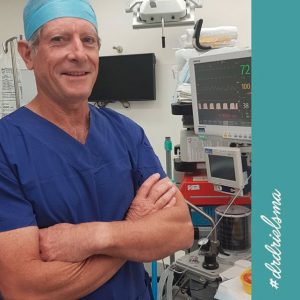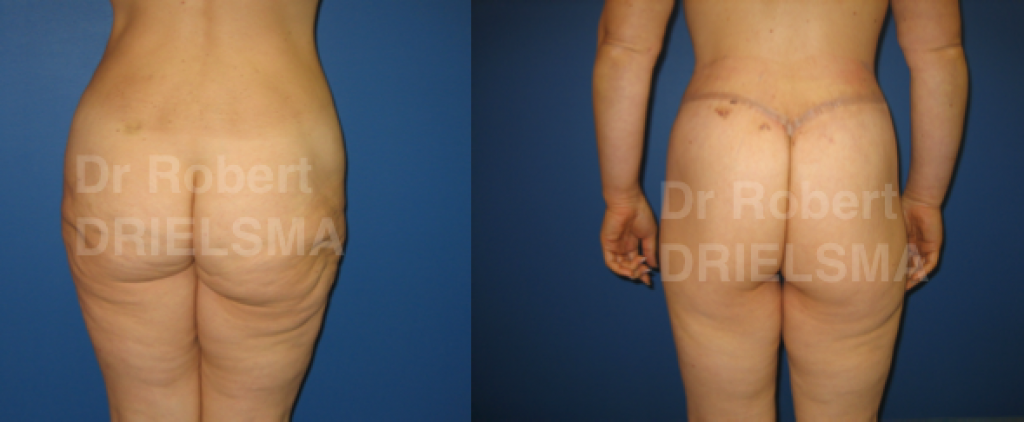Warning: Undefined array key "target" in /home/sh10236/public_html/wp-content/themes/drdrielsma/functions.php on line 72
Warning: Undefined array key "target" in /home/sh10236/public_html/wp-content/themes/drdrielsma/functions.php on line 72
Warning: Undefined array key "target" in /home/sh10236/public_html/wp-content/themes/drdrielsma/functions.php on line 72
Body lift surgery, or circumferential lipectomy, is an operation that removes excess flabby skin from the tummy, outer thighs, hips and buttocks. Most patients seek this following significant to massive weight loss.

Bodylift (circumferential lipectomy) is far less common than an abdominoplasty, which tightens skin only in the front. Relatively recently experts recognise the importance of skin laxity and collapse of the outer hip, thigh and buttock regions. In such cases, just as removing the excess skin and fat from the front of the body (abdominoplasty) makes sense, so does removal of excess skin and fat from the sides and back of the body.

Procedure Information:
Operating Time: 7.5 Hours
Hospital Stay: 3-4 nights
Recovery Time: Approx. 4 weeks
Following massive weight loss, which is becoming more common with the growing popularity of bariatric surgery and fitness training drives, a concern of massive skin excess and laxity develops. This affects primarily the lower body (abdomen, lateral thighs and buttocks) as well as the inner thighs, arms, breasts and face. Body lift (circumferential lipectomy) surgery aims to deal with the most common concern of the massive weight loss patient, that of skin excess and laxity of the abdomen, lateral thigh and buttock regions.
Body lift (circumferential lipectomy) surgery is an extension of the abdominoplasty principle to reverse collapse of the whole flabby mid body including abdomen, hips, thighs and buttocks. Because skin tightening and lifting occurs to all these areas, an entire body lift (circumferential lipectomy) achieves dramatic results. The operation is quite large taking around 7 to 8 hours. Body lift (circumferential lipectomy) generally requires a hospitalisation of 3 to 5 days with a recovery period of 4 to 6 weeks. This is quite an involved procedure and careful time and consideration should be taken by all patients who are considering this procedure.
How is the Operation done?
Dr Drielsma makes an incision in a belt like fashion around the front of the lower abdomen, outer thigh region and upper bottom region to remove a large amount of loose skin and fat. The operation resembles an abdominoplasty (or tummy tuck) at the front and extends around the sides to the back. The remaining skin tightens dramatically after the removal of the loose skin.
BEFORE AND AFTER PHOTOSBody lift (circumferential lipectomy) surgery is performed under general anaesthetic and takes approximately 7 to 8 hours. A device called a pain buster helps minimise discomfort along the wound lines during the hospital stay. Body lift (circumferential lipectomy) surgery usually requires Usually 3 to 4 nights stay in hospital.
After the surgery you will wear a garment to provide support to the abdomen. We will fit and order this garment prior to the operation.You will wear it for 6 weeks following surgery. We encourage early mobilisation with walking etc.
Stitches are all absorbable and do not need removal.
A special glued on dressing is left on the stitch line for 3 to 4 weeks. This protects and supports the stitch line in the early healing phase and showering can be done normally with this dressing on.
When can I return to normal activities?
You will usually require 4 to 6 weeks off work although some people require a longer recovery period. You can commence gentle exercises after 6 weeks, however, vigorous exercise should be for 8 weeks. It may take 2-3 months before returning to completely normal activity.
Are there any risks?
As with any surgical procedure, there is a risk of complications. Surgery and anaesthesia are safe and it is unlikely you will experience any difficulty. However, there are areas of potential problems you need to understand before proceeding with your surgery. You can reduce your risk of complications by closely following instructions before and after surgery.
Bleeding
Bleeding can be problematical in about 2% of cases. It is possible in cases bleeding that return to the operating theatre will be necessary and sometimes require blood transfusion.
Infection
If infection occurs it will usually become evident within one week of surgery and may delay the healing process or result in the development of scar tissue. This may require treatment with antibiotics. In the event of infection, this may adversely affect the ultimate result of the surgery.
Anaesthesia
The surgery is done under a general anaesthetic and the anaesthetist will be discussing the possible discomforts following anaesthesia. Any questions you have regarding your anaesthetic would be best answered by the anaesthetist at the time of surgery.
Scarring
All surgery carries risks and every incision leaves a scar. Scars do however fade remarkably well over a one to two year period and become much less noticeable. The scar of body lifting is never invisible but Dr in a position that is inconspicuous when wearing most clothing or swimming costumes.
The scars will often look red and thickened at about three months after surgery as they heal but this is normal and will settle over the following 3-6 months. It takes 12-18 months before the scars mature completely, flatten out and lighten in colour.
Sensation
Areas of your lower abdomen may be numb for up to six months as bruised nerves are recovering. Some minor residual permanent alteration in sensation may occur.
Fluid Collection
A seroma is a collection of fluid under the skin and fat. If this occurs it may take a few weeks to absorb. This may require aspiration or sucking out via a needle. Wearing the pressure garment will help reduce this risk.
Circulation
Although rare, there is a risk of clotting in the veins of the legs. The risk of this is about one in 500 and increases with use of the oral contraceptive pill. All possible precautions are taken to minimise the risks of thrombosis including use of leg compression devices during surgery, use of TED stockings and anti-clotting injections while in hospital.
Important points to remember before proceeding with surgery:
- There can be no absolute guarantee with any surgery. In the hands of any experienced surgeon, a secondary operation to correct an asymmetry or irregularity may be needed.
- Should there be any questions regarding abdominoplasty or body lifting, be sure they are answered in advance by Dr Drielsma. Well meaning friends are not a good source of information. Find out everything before the operation – a well informed patient is a happy one.
- It is important that you make the decision to proceed with surgery for yourself, not anyone else.
The next step when considering body lifting (circumferential lipectomy) surgery is a consultation with Dr Drielsma. Dr Drielsma will show you before and after photos, and assess your suitability for surgery as well as explain the procedure fully to you in detail.
**All surgery carries risks. Results may vary for individual to individual. You should see another Specialist Plastic Surgeon for a second opinion before proceeding with surgery.
Dr Drielsma is a Specialist Plastic Surgeon.




